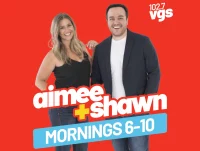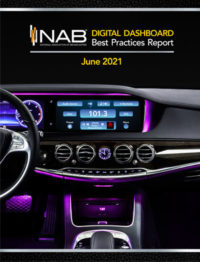At the beginning of a new year, I like to spend some time thinking about what skills I want to add to my repertoire. These types of New Year’s resolutions not only excite me more than the thought of trying to quit smoking or lose 15 pounds, but I also find them more achievable. With that in mind, I’ve put together a list of skills that broadcasters should consider learning this year.
 The idea here is not for you to learn all of them, but rather to pick one that excites you and to treat it like a hobby. Your goal is not necessarily to do something that generates ratings or revenue, but rather to learn something new. If you do happen to produce something, that’s a bonus, but don’t make it your primary purpose. That puts too much pressure on what should be a fun discovery process.
The idea here is not for you to learn all of them, but rather to pick one that excites you and to treat it like a hobby. Your goal is not necessarily to do something that generates ratings or revenue, but rather to learn something new. If you do happen to produce something, that’s a bonus, but don’t make it your primary purpose. That puts too much pressure on what should be a fun discovery process.
I tried to be practical with this list. While there’s lots of fascinating new technologies on the horizon — from The Metaverse and augmented reality to voice commands and microtransactions — many of those things are either too far into the future to be immediately useful, or require too much capital and specialized equipment for the average individual to experiment with. If you’re interested in those larger technological trends, I encourage you to watch Fred and Paul Jacobs’ webinar about their recent trip to CES in Las Vegas.
Instead, I have tried to put together a list of things that everyday broadcasters can teach themselves without having to secure buy-in or a budgetary commitment from their boss. These are things that you can not just read about, but in many cases also get under the hood and experiment with on your own. Best of all, any of the skills will make you more valuable in your current role and more employable in the future. So pick one and dig in:
1. Video Creation
For many years, I used the old “face for radio” joke as an excuse to avoid learning video. But this is a skill that radio broadcasters — especially on-air personalities — can no longer afford to put off. The reality is that everybody now has a videocamera in their pocket, so if you haven’t embraced video yet, you’re not just falling behind other broadcasters — you’re falling behind your listeners!
This year, pick a video medium and master it. The three most important are YouTube, Instagram, and TikTok. Select the one that calls out to you and figure out how it works. Also, figure out how it is different from the others. Don’t just read about it or consume content from others on this platform; create your own. Don’t worry if it’s any good or not. As Nike says, “Just do it.” Trust me, your hundredth video is going to be better than your first video just because it’s your hundredth video.
2. Livestreaming Video
I’ve included livestreaming as a separate skill because it’s different than on-demand video, in much the same way that creating Wednesday for Netflix isn’t the same thing as producing a newscast for CNN. There are multiple platforms for livestreaming video, but I would encourage you to learn Twitch, in large part because Twitch is only about livestreaming video, as opposed to YouTube or Facebook, where livestreaming is just one of many offerings.

I learned
a lot about livestreaming video by watching my friend Shawn Tempesta in Las Vegas. Last summer, Shawn landed his dream job of anchoring a radio morning show on 102.7 VGS. Although he is an incredibly talented broadcaster with both TV and radio experience, for many years he found himself in a position that many of us can relate to: He was stuck in afternoon drive, trying to convince the Powers That Be to take a chance and give him a morning show.
So what did Shawn do? He launched a livestreaming game show on Twitch. No only did this show play a key a role in convincing the Powers that he was ready for a morning show, but it also helped him hone skills that would make him an even better morning host.
One of those skills relates to the key difference between livestreaming video and on-demand video. When Shawn and I first started talking about Twitch, I didn’t understand the appeal. Why would anybody waste their time watching other people play video games or read comments from the audience when there’s higher quality video content like Stranger Things or Everything Everywhere All At Once out there? But Shawn explained to me that the important feature wasn’t the production value, but the audience engagement. (Though, to be sure, Shawn’s show was very slickly produced.)
Here’s an analogy: When I was a kid, my favorite book was Lord of the Rings by J.R.R. Tolkein. Lord of the Rings is a work of literature. Tolkein invented languages and mythologies; he drew maps and family trees; he wrote songs and prophecies. I mean, that thing is a work of art. And that’s why I liked it.
 I also liked Choose Your Own Adventure books. And as art goes, Choose Your Own Adventure books are not in the same league. But they appealed to me for a different reason. Even though these books did not have the same high production values of Tolkein’s works, I, as the reader, could influence the plot of the story. I made decisions that had an impact on where it went.
I also liked Choose Your Own Adventure books. And as art goes, Choose Your Own Adventure books are not in the same league. But they appealed to me for a different reason. Even though these books did not have the same high production values of Tolkein’s works, I, as the reader, could influence the plot of the story. I made decisions that had an impact on where it went.
And that’s the crucial ingredient in livestreaming: The audience participates in the show in a way that impacts what happens on the screen. While hosting his show on Twitch, Shawn learned the intricacies of letting the audience play a role in the show. The ability to master that improvisational skill is one of the things that separates great radio morning show hosts from the hosts on other dayparts.
So if you’re itching to host a morning show in the future, consider teaching yourself to livestream video this year.
3. Community Building
For years, I have been helping radio stations pull all their different digital tools into a coherent overarching plan using a strategy known as Content Marketing. The crux of Content Marketing is pretty simple: create great content to attract an audience. The reality is that radio has always been about Content Marketing, it’s just that stations have been primarily focused on on-air content. I help them do it on the internet.
Once upon a time, in order to create content that could reach mass audiences, you needed big expensive equipment that required experts to use: a printing press, a radio station, or television studio. Nowadays, every person on the street with a smartphone and an internet connection can create content for the world to see. The result? There’s so much content that cutting through the noise has become increasingly difficult.
Audiences are drowning in so much content that they are looking for ways to filter through it all. How are they filtering? Through their communities.
We see this in the podcasting space, where the number one way that people discover new shows is not through Google Searches or Spotify ads or social media; it’s through word of mouth. People recommend shows they like to other people.
The same is happening with television shows. At every gathering I attend, the conversation inevitably turns to what people are watching. With so many shows now available through Netflix, Hulu, Amazon Prime, HBO Max, etc., we use the people around us to filter the content.
For a long time, the conventional wisdom has been that Content is King: If you create the best content, it will rise to the top.
But in the coming years I think Content could be dethroned. We may be entering an age where Community is King, and Content only cuts through when it has a Community to support it.
 Too many people use the word “community” incorrectly. To build a community, you must create a space where people can gather, communicate, and bond with one another. Your radio station’s audience is not a community. Your email list is not a community. Your Facebook page followers are not a community. These are audiences that you attracted by creating great content. While you can talk to that audience, those audience members do not talk to each other.
Too many people use the word “community” incorrectly. To build a community, you must create a space where people can gather, communicate, and bond with one another. Your radio station’s audience is not a community. Your email list is not a community. Your Facebook page followers are not a community. These are audiences that you attracted by creating great content. While you can talk to that audience, those audience members do not talk to each other.
By contrast, a Facebook group can be a community. A Slack channel can be a community. A networking event for local musicians can be a community. All of these involve the creation of a space where people can gather and talk with each other.
The skills needed to build a community are not the same skills needed to create content that attracts an audience. In fact, the skills required to build a community are similar to those needed to be a good party host: you need to get people to show up, make sure everybody has a good time, toss out any troublemakers, etc. Community builders are more like wedding planners than wedding singers.
How can you practice building a community? Perhaps the easiest place to start is by launching a Facebook group. The key here is to focus on a subset of your audience that would want to talk to each other. Instead of launching the “WKRP Fans” group or the “Dick and Jane Morning Zoo Fans” group, launch a group for local musicians, foodies, or parents with young kids. Figure out what it takes to get people to not just join the group but also participate in the group. If you can unlock the secrets to growing a thriving community, you will have gained a very useful skill.
4. Hosting Virtual Events
Virtual events are another way to create a space for community members to gather. The key difference between a virtual event and an online community, such as a Facebook group, is that at a virtual event, the interactions take place in real time; in an online community, they are asynchronous. Try your hand at hosting a virtual event on Zoom, or step up your game and use a platform like Remo, AirMeet, or HopIn.
5. Content Creation with Artificial Intelligence (AI)
AI is here. In fact, it’s been here for a minute. There’s been a lot of buzz about ChatGPT, the artificial intelligence writing tool, lately. But this is an easier-to-use evolution of tools that were already in use.
Writing is an essential skill for broadcasters. Yet I know so many who love talking on the radio but hate writing. If that describes you, consider learning to use AI writing tools. These tools essentially make you an editor instead of an author. You let them write the first draft, and then you can fine-tune it.
If you’re wondering how this might help your radio career, here are some ideas.
6. Making Radio Look Good in the Dashboard
At Jacobs Media, we’ve been warning broadcasters for nearly a decade: The cars coming off the assembly lines today have computer screens in their dashboards, not tuners. That means that what matters for the in-car experience isn’t just how your radio station sounds; it’s also about how it looks.
Spotify and Sirius look appealing in the dashboard. Too often, terrestrial radio stations don’t.
 Want to become a hero in your radio station? Appoint yourself the Dashboard Czar and make it your mission to learn everything you can about how to make your station look fantastic inside a moving vehicle. Here are three places to start:
Want to become a hero in your radio station? Appoint yourself the Dashboard Czar and make it your mission to learn everything you can about how to make your station look fantastic inside a moving vehicle. Here are three places to start:
- Read the Best Practice Report and watch the webcast that we produced with the NAB.
- Read this new ebook from RadioWorld on the topic.
- Go to some local car dealerships and have the salespeople show off their dashboard infotainment systems. Don’t let them know you work in radio; this is an undercover mission.
From there, the next steps should reveal themselves. But if they don’t, reach out to us. We’ve been working on this issue for years and we love talking about it.
7. Implementing Google Analytics 4
Google has been slow-rolling the introduction of Google Analytics 4, which will replace the Universal Analytics. But come July 1st, Universal Analytics will be completely phased out, so now is the time to learn the ins and outs of the new measurement tool.
What’s the difference between Google Analytics 4 and Universal Analytics? According to Google:
Universal Analytics was built for a generation of online measurement that was anchored in the desktop web, independent sessions and more easily observable data from cookies. This measurement methodology is quickly becoming obsolete. Meanwhile, Google Analytics 4 operates across platforms, does not rely exclusively on cookies and uses an event-based data model to deliver user-centric measurement.
And though Universal Analytics offers a variety of privacy controls, Google Analytics 4 is designed with privacy at its core to provide a better experience for both our customers and their users. It helps businesses meet evolving needs and user expectations, with more comprehensive and granular controls for data collection and usage. Importantly, Google Analytics 4 will also no longer store IP addresses. These solutions and controls are especially necessary in today’s international data privacy landscape, where users are increasingly expecting more privacy protections and control over their data.
In short, Google Analytics 4 is designed for a world where people are spending more time in apps on their phones and are more concerned about privacy issues. Somebody at your radio station is going to need to become an expert in the new analytics. It might as well be you.
As I said at the outset, don’t try to take all of these on. After all, you’ve still got a regular job (or four) to do. Pick the one that speaks to you and carve out an hour or two per week and see what happens.
If you’ve got any other digital skills that you think I should add to the list, let me know in the comments below.
- A Simple Digital Treat to Thank Your Radio Listeners This Thanksgiving - November 13, 2023
- Interview Questions When Hiring Your Radio Station’s Next Digital Marketing Manager - November 6, 2023
- A Radio Conversation with ChatGPT: Part 2 – Promotions - October 30, 2023





Leave a Reply